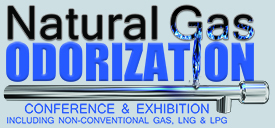Natural Gas Odorization
CONFERENCE & EXHIBITION
INCLUDING NON-CONVENTIONAL GAS, LNG & LPG
August 27-28, 2019 | Houston, Texas
Conference Schedule
| Monday, August 26 | ||
|---|---|---|
| 5:00 - 6:00pm | Welcome Reception in the Exhibition Hall, registration | |
| Tuesday, August 27 | ||
| 7:30am | Registration, coffee | |
| 8:45am | Opening remarks, introductions | |
| 9:00am - 5:00pm | Technical presentations, Exhibits open | |
| 5:00-6:30pm | Cocktail Reception in the Exhibition Hall | |
| Wednesday, August 28 | ||
| 9:00am - 1:30pm | Exhibits open | |
| 9:00am - 3:30pm | Technical presentations, end of conference | |
Technical Program
Tuesday, August 27 |
||
| 7.30 | Registration, coffee | |
| 8.45 | Opening remarks, introductions | |
| Monitoring & Measurement | ||
| 9.00 | [1] | How Washington Gas monitors and maintains proper odorant levels in gas from multiple suppliers |
| Joe Marx, Washington Gas, Springfield, VA, USA | ||
| 9.35 | [2] | Continuous monitoring of odorant compounds in vaporized LPG matrices by an autonomous process gas chromatograph |
| Damien Bazin, Sara Gutiérrez-Sama, Jean-Philippe Amiet, Louis Vivola, Franck Amiet, Chromatotec, Saint-Antoine, France | ||
| 10.10 | [3] | Odor intensity monitoring and methodology |
| Steven Chancey, Heath Consultants, Houston, TX, USA | ||
| 10.45 | Coffee | |
| Non-conventional gas | ||
| 11.45 | [4] | Renewable Natural Gases: new challenge for gas odorization |
| Amélie Louvat, GRTgaz, Villeneuve la Garenne, France | ||
| 12.20 | [5] | Shale gas and biogas odorization issues and experience |
| Pawel Olszewski, Walter Richter, LEWA GmbH, Leonberg, Germany | ||
| 1.00 | Lunch | |
| 2.15 | [6] | LNG odorization – batch odorization for increased safety in new LNG uses |
| Jean-Benoit Cazaux, Peter Meyer, ARKEMA, Colombes, France | ||
| Practice & operations | ||
| 2.50 | [7] | Safe odorant handling |
| Juraj Strmen, Midland Resource Recovery, Philippi, WV, USA | ||
| 3.25 | Coffee | |
| 3.50 | [8] | Pre-odorization project planning & examples |
| Dale Smith, Daniel Blata, Enbridge Gas, Chatham, ON, Canada | ||
| 4.25 | [9] | Methods to odorize new plastic and steel gas mains; innovative use of a portable odorant wicking and monitoring system |
| Thomas Muccio, Joseph Rodak, National Grid, Melville, NY, USA | ||
| 5.00 | Reception | |
Wednesday, August 28 |
||
| Practice & operations (cont’d) | ||
| 9.00 | Day 2 opening remarks, Day 1 review | |
| 9.10 | [10] | Natural gas odor level testing programs |
| Mark Gunsalus, Mulcare Pipeline Solutions, Dudley, MA, USA | ||
| 9.45 | [11] | In-service pipeline conditioning |
| Richard DeAngelo, Pipeline Equipment Resources Company, DuBois, PA, USA | ||
| 10.20 | [12] | Pipeline pickling |
| Wesley Lucas, Midland Resource Recovery, Philippi, WV, USA | ||
| 10.55 | Coffee | |
| Odorant Loss, Environmental Issues | ||
| 11.40 | [13] | A New Approach to Gas Explosions and Soil Scrub of Odorants |
| David Heldenbrand, Bison Engineering, Inc., Kingwood, TX, USA | ||
| 12.15 | [14] | Odorant breakthrough in pipelines using mixed odorants – an Australian study |
| Chris Ulrik, Vanessa Tunjano, International Chemicals Engineering, Dandenong, Australia, Dr Charles Cornwell, Gas Technology Services, Victoria, Australia | ||
| 12.50 | Lunch | |
| Research & Standards | ||
| 2.00 | [15] | Odorization research at Gas Technology Institute |
| Karen Crippen, Sandeep Alavandi, Brian Landreth, GTI, Des Plaines, IL, USA | ||
| 2.35 | [16] | Panel session: Updates and revisions to the AGA Odorization Manual |
| 3.10 | Facilitators: Dave Bull, Paul Wehnert, Mark Gunsalus | |

